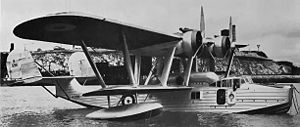Saro London Video - Picture

|
|
Saro London

Picture - A Saro London II of No. 204 Squadron RAF shown fitted with the dorsal fuel tank
Role: Reconnaissance flying-boat
Manufacturer: Saunders-Roe Ltd
First flight: March, 1934
Introduction: 1936
Retired: 1941
Primary users: Royal Air Force
Royal Canadian Air Force
Produced: 1934 - 1938
Number built: 31
Developed from: Saro A.7 Severn
The Saunders Roe A.27 London was a British military biplane flying boat built by the Saunders Roe company. Only 31 were built, entering service with the Royal Air Force in 1936. Although due for replacement by the outbreak of World War II, they saw some active service pending the introduction of the ultimately unsuccessful Lerwick.
Development
The A.27 London was designed in response to the Air Ministry Specification R24/31 issued for a "General Purpose Open Sea Patrol Flying Boat" and was based on the Saro A.7 Severn. The London and its contemporary, the Supermarine Stranraer, were the last multi-engine, biplane flying-boats to see service with the RAF. The first prototype flew in 1934 fitted with two Bristol Pegasus II radial engines, mounted on the upper wing to keep them clear of spray while taking off and landing. The initial aircraft then went on to serve from 1934 - 1936 with 209 and 210 Squadrons RAF at RAF Felixstowe and Gibraltar respectively.
The first deliveries of production aircraft began in March 1936 with Pegasus III engines, and from the eleventh aircraft onwards the Pegasus X engine was fitted instead and the aircraft's designation changed to London Mk.II. Earlier Londons were retrofitted with the Pegasus X and were also given the "Mk.II" designation. This model equipped 201 Squadron RAF at RAF Calshot, replacing Supermarine Southamptons. Others were delivered in October of the same year to 204 Squadron RAF at RAF Mount Batten, Plymouth, also replacing Southamptons. More were delivered to the same squadron the following year to replace Blackburn Perths, and to 202 Squadron RAF at Kalafrana, Malta, replacing Supermarine Scapas, and 228 Squadron RAF at Pembroke Dock.
In 1937-1938 204 Squadron RAF used five Londons equipped with auxiliary external fuel tanks for a long-distance training flight to Australia to celebrate the 150th anniversary of the founding of the Colony at Sydney, New South Wales. In this configuration they had a range of 2,600 miles (4,180 km).
Operational history
By the outbreak of World War II in September 1939, Londons still equipped 201 Squadron RAF which was by now stationed at Sullom Voe in Shetland, and 202 Squadron RAF at Gibraltar. 240 Squadron RAF at Invergordon had also re-equipped with Londons in July 1939. These aircraft carried out active patrols over the North Sea and the Mediterranean. Some were fitted with a dorsal fuel tank to increase operational radius. Armaments in the form of bombs, depth charges and mines up to a total weight of 2,000 lb (907 kg) could be carried beneath the lower wings. Gradually, the Londons' duties were assumed by newer aircraft such as the Lockheed Hudson while squadrons flying Atlantic and Mediterranean patrols were re-equipped with Short Sunderlands. Some were transferred to the Royal Canadian Air Force.
Variants
Prototype
One only
London Mk.I
10 built with two 820 hp Pegasus III engines and two-bladed propellers. Later converted to Mk II.
London Mk.II
20 built with two 915 hp Pegasus X engines and four-bladed propellers.
Operators
Canada
Royal Canadian Air Force
United Kingdom
Royal Air Force
No. 201 Squadron RAF (Apr 1936 - Apr 1940)
No. 202 Squadron RAF (Sep 1937 - Jun 1941)
No. 204 Squadron RAF (Oct 1936 - Jul 1939)
No. 209 Squadron RAF (Oct 1934 - Feb 1936)
No. 210 Squadron RAF (Oct 1935 - Nov 1935)
No. 228 Squadron RAF (Feb 1937 - Sep 1938)
No. 240 Squadron RAF (Jul 1939 - Jul 1940)
Specifications (London Mk.II)

Picture -
Data from War Planes of the Second World War: Volume Five Flying Boats
General characteristics
Crew: Six
Length: 56 ft 6 in (17.23 m)
Wingspan: 80 ft 0 in (24.39 m)
Height: 18 ft 9 in (5.72 m)
Wing area: 1,425 ft² (132.4 m²)
Empty weight: 11,100 lb (5,045 kg)
Loaded weight: 18,400 lb (8,364 kg)
Max takeoff weight: 22,000 lb (10,000 kg)
Powerplant: 2x— Bristol Pegasus X 9-cylinder air-cooled radial engines, 915 hp (682 kW) each
Performance
Maximum speed: 135 knots (155 mph, 250 km/h) at 6,560 ft (2,000 m)
Cruise speed: 111 knots (128 mph, 206 km/h) at 13,120 ft (4,000 m) (60% power)
Range: 956 nmi (1,100 mi, 1,770 km)
Ferry range: 1,510 nm (1,740 mi, 2,800 km) with auxiliary fuel tank over fuselage
Service ceiling: 19,900 ft (6,067 m)
Rate of climb: 1,180 ft/min (6.0 m/s)
Armament
Guns: 3 x— Lewis guns
Bombs: 2,000 lb (900 kg) of bombs, mines or depth charges
Comparable aircraft
Supermarine Stranraer
Bibliography
Green, William. War Planes of the Second World War, Volume Five: Flying Boats. London: Macdonald & Co. (Publishers) Ltd., 1962 (Fifth impression 1972). ISBN 0-356-01449-5.
Jefford, Wing Commander C.G., MBE, BA, RAF(Retd.). RAF Squadrons, a Comprehensive record of the Movement and Equipment of all RAF Squadrons and their Antecedents since 1912. Shrewsbury, Shropshire, UK: Airlife Publishing, 1988 (second edition 2001). ISBN 1-85310-053-6.
London, Peter. Saunders and Saro Aircraft Since 1917. London: Putnam (Conway Maritime Press), London, 1988. ISBN 0-85177-814-3.
March, Daniel J. British Warplanes of World War II: Combat Aircraft of the RAF and Fleet AIr Arm, 1939-1945. Hoo, near Rochester, Kent, UK: Aerospace Publishing Ltd., 1998. ISBN 1-84013-391-0.
Mondey, David. The Hamlyn Concise Guide to British Aircraft of World War II. Hamlyn (publishers),1982 (republished 1994 by Chancellor Press, reprinted 2002). ISBN 1-85152-668-4.
Saro London Pictures
More airplane videos.
Source: WikiPedia